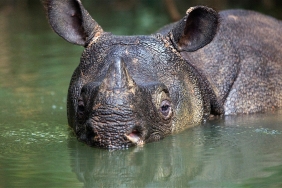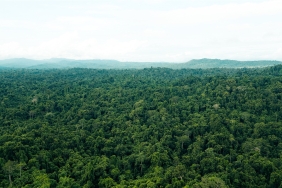VETERINARIAN YANTI, BRAVELY FIGHTING FOR THE "FREEDOM" OF SUMATRAN TIGERS
By: Natalia Trita Agnika
The high spirit of the 71st independence celebration of the Republic of Indonesia can be seen from the many red and white attributes that adorn various places. Race after race was held with great fanfare all the way to remote villages. Social media is also colored with various photos and statuses that show the response to the independence that has been felt for 71 years, complete from various sides. Of the many responses to the 71st Anniversary of the Republic of Indonesia, more people questioned what this country had achieved. Not a few also demand improvements to conditions that are still considered not reflecting independence. Rarely do they ask, "Has my work made a positive contribution in filling this independence?"
Of the many people who have contributed positively to this nation, drh. Yanti. The owner of the full name Erni Suyanti Musabine once shocked social media for bravely being in one boat with a Sumatran tiger that had to be evacuated immediately. At that time, October 28, 2015, drh. Yanti relocated two tigers, a male and a female, from the Bengkulu BKSDA to the Seblat Nature Tourism Park (TWA) conservation area in North Bengkulu Regency. The male tiger was a victim of conflict with humans, while the female tiger was a victim of a poacher's snare and had to have her leg amputated. After receiving medical treatment at BKSDA and their condition improved, the tigers were moved to the forest because TWA Seblat is a more suitable location and the tigers can be isolated from humans to maintain their normal natural behavior. However, there is no road access to TWA Seblat, the only way is to cross it via the Seblat River.
Together with the Wildlife Rescue Unit of BKSDA Bengkulu and TPCU (Tiger Protection and Conservation Unit) - TNKS, drh. Yanti conducted the relocation using a boat. About 15 minutes, drh. Yanti and the tiger on the boat crossed the Seblat River with a strong current. In the boat, there was only drh. Yanti and the tiger only because she had to control the tiger's physiological condition at all times while it was sedated and also had to always carry medicine and emergency equipment in case there were emergency cases that needed to be handled during transportation. "As a veterinarian in charge of anesthesia, I cannot leave the tiger alone under anesthesia but have to constantly monitor its condition and be nearby," he explained to WWF-Indonesia.
The evacuation process starting from the anesthesia process on the other side of the river, crossing the river, to guiding him to the forest where the tiger was treated took approximately one hour. Every 10 minutes, this brave veterinarian stopped to check the vital signs on the tiger (heart rate, respiration, and body temperature).
Actually, drh. Yanti is actually the Veterinary Medic (veterinarian) & Wildlife Rescue Unit at BKSDA Bengkulu. Since 2007, this brave woman has been involved in efforts to save Sumatran tigers with the Tiger Protection and Conservation Unit or better known as PHS-KS, the Tiger Patrol Team of Kerinci Seblat National Park. Since then, drh. Yanti often assists in tiger rescues and provides training on tiger rescue and handling for field officers, provides training on wildlife-human conflict management, helps treat and translocate tigers with problems such as snare victims, gunshot wounds, poisoning, and those suffering from infectious diseases. In addition, he also assists in veterinary forensic examinations.
When dealing with tiger conflicts, the woman who used to aspire to be an architect lives with the communities affected by the conflict. She looks after the tigers and makes sure they are safe from poachers or anarchists, but at the same time provides a sense of security to the community. Together with village officials and partners, drh. Yanti will patrol to monitor the presence of tigers and their roaming paths, conduct socialization to the community on how to avoid conflict with tigers, socialize the design of livestock cages that are safe from tiger attacks, and evacuate if a tiger is found in a problematic condition such as sick, injuring or killing people, injured, etc.
To date, drh. Yanti and TPCU have handled 4 tiger victims of snares, infectious diseases, poisoning, and conflict victims in Jambi and Bengkulu Provinces. While with the Wildlife Rescue Unit of Bengkulu BKSDA, drh. Yanti has handled 9 individual tigers in Bengkulu Province. Most of them were victims of poachers' snares, suffered from gunshot wounds, and sharp weapon abuse that had to be amputated. She has also been seconded to the West Sumatra BKSDA for medical examinations and ultrasonography for Sumatran tigers that will be released back to their habitat.
Memorable experiences
During his struggle to save Sumatran tigers, his most memorable experience was when he first rescued a Sumatran tiger from a poacher's snare in a rubber and chocolate plantation in North Bengkulu in 2007. At that time, there was no adequate anesthesia equipment and medicines, only anesthetic. Everyone demanded that he take immediate action. Finally, the tiger was rescued with a hand injection. People who were at the location secured themselves up the rubber tree. Down below there was only drh. Yanti, a forestry policeman, and a member of the TNI. "I was criticized by many people because what I was doing was very dangerous and risky. But there was no choice," he recalled.
The Sumatran tiger rescue event in 2012 was no less memorable. Together with TPCU TN. Kerinci Seblat and Wildlife Rescue Unit BKSDA Bengkulu, drh. Yanti rescued an entangled tiger in the Air Rami Production Forest area, Bengkulu. To reach the location, she and her group took three days, consisting of one day traveling by car, followed by two days walking through several hills, ravines, and crossing rivers upstream. They also had to compete in walking speed with poachers who also entered the forest at the same time to take the tiger. "Finally, the tiger could be saved. We performed amputation surgery and medical treatment in the forest for more than 7 days. After that, it was evacuated to the Bengkulu BKSDA office for further treatment and skin transplant surgery and treated there until it recovered with very limited facilities," drh. Yanti recounted.
Saving tigers does not stop at removing snares and evacuation. The treatment process is sometimes even the most draining of energy, thoughts, and tears. The tiger rescue in 2014 is one example. Without financial support, drh. Yanti had to treat and care for the tiger with adequate food until she had to do fundraising. Not many were interested in helping at the time. There were some parties and individuals who helped. Sometimes there was help, sometimes not. "When I myself ran out of money and received no help from other parties, and found the fact that the tiger was hungry, I could only cry in his cage," said drh. Yanti.
All her efforts for Sumatran tigers are based on love. According to her, tigers are one of the wild animals that have tolerance and reciprocity, including to humans who have helped them, as long as we never hurt them. Normal behavior, tigers prefer to avoid humans. Tigers only come into conflict with humans when cubs are killed, tigers are harmed, their habitat is destroyed, and prey animals are taken/hunted. If left alone, tigers will not bother humans either. This animal even has a role in controlling agricultural and plantation crop pests.
In the midst of limited facilities and all the challenges that face her, drh. Yanti continues to fight to save Sumatran tigers with passion. Her contribution to the "freedom" of protected wildlife is an inspiration for us to carry out similar struggles according to our capacity. Now is the time for us to ask ourselves, "What have I done for this beloved country of Indonesia?"
Let us fill our independence with the spirit of fighting for the "freedom" of wildlife to live in their natural habitat.





